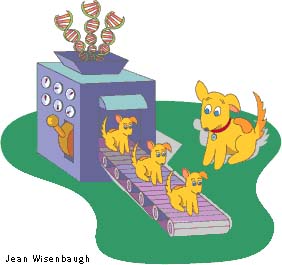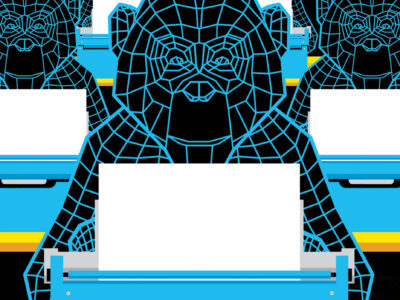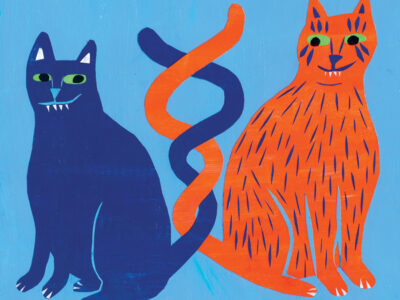
Ever since Scottish scientists announced the birth of a cloned lamb named Dolly last year, scholars, pundits, and policy-makers have been mulling over the consequences for humans. But a seminar organized last month by the Veterinary School’s Center for the Interactions of Animals and Society and the Center for Bioethics examined a different angle — the implications of all kinds of genetic engineering for animals.
“As so often happens in these debates, the animals tend to get overlooked,” said Dr. Glenn McGee, assistant professor and associate director of education at the Center for Bioethics. Even the National Bioethics Advisory Commission, appointed by President Clinton to examine ethical issues in cloning, is concentrating “entirely on what we ought to do with human embryos and with potential human subjects.” Yet, he added, “there are some very far-reaching implications for the ways animals are being used and treated.”
Dr. Gary Comstock, a theologian and coordinator of the Bioethics Program at Iowa State University, discussed the production of transgenic mammals for research. (These are animals into which has been inserted a foreign gene from another species with which it cannot sexually reproduce.) He displayed an ad, put out by a company that sells transgenic mice, featuring a robust-looking rodent in sneakers. “You kind of get the feeling this little critter is getting ready to take on Michael Johnson in the 100-meter dash,” Comstock said. “But things look different in the lab.”
The next mice models were much less photogenic: One had spina bifida. Another, bred for oncology research, had acne-like cysts that made its fur drop out. Another appeared as just a blur. It’s known as “the shiverer,” because it has a condition similar to multiple sclerosis, which makes it tremble when it tries to move.
Supporters of transgenic-animal research argue that without such mice, progress in numerous fields of lifesaving medicine would suffer. Dr. Alan Shaw, a scientist at Merck Pharmaceuticals who develops vaccines for children, pointed out that transgenic mice are used in the quest for an HIV vaccine. Such research, he said, yields a “fairly high payoff in societal terms.”
While many people maintain that society should prohibit genetic engineering because it’s “unnatural,” Comstock examined that argument and found it wanting. Although some contend that to engage in animal-engineering is to employ a world-changing technology — an activity that should be reserved for God alone — Comstock noted that agriculture was a world-changing technology when it was developed 10,000 years ago. He suggested some more “constructive” ways to consider the issue, one being the principle of proportionality: “The harm done to a transgenic animal by changing one of its traits is proportional to the importance of the trait to the animal. The less important the trait, the less the harm. I think minor damage done to an animal’s coat may be justified if the animal doesn’t notice. I think to make a mouse tremble whenever it tries to move is to do grave harm.”
Dr. Gary Varner, an animal-rights advocate and associate professor of philosophy at Texas A & M University, believes that experimentation which causes harm to animals is justified if it saves more lives. That said, he would like to see more lay people serving on animal-care-and-use committees and for them to be given explicit permission to turn down studies that they don’t think are worth the harm caused to the animal subjects.
Inevitably, the issue of cloning housepets was raised. What kinds of rights do they have, and would cloning hurt them?
Dr. Arthur Caplan, director of the Center for Bioethics, doesn’t think so. Of course, cloning pets who have severe genetic conditions that would impair their quality or length of life, such as hip dysplasia, would be cruel, he said. On the other hand, if you could genetically enhance your pet by cloning — preventing parvovirus, for example — there might be a moral obligation to do so.
But if you’re expecting to recreate the special moments you shared with Fluffy or Spot, Caplan warned, you may be disappointed. Their clones may look the same and even share some general personality traits with your old pet, but they will be shaped by a different set of experiences. “That may prove hard to accept for someone once they realize that the bonds they think they had with their former pet can’t be recreated. Old Fido doesn’t remember how to fetch and doesn’t have that fondness for that particular ball or stick that it used to take when you went on a walk, and so on … ” For humans, the same limitations would apply. “If you try to recreate your daughter or your girlfriend, you’re not going to be able to do it. That’s what’s so hollow about all that conversation about achieving your immortality through cloning.”
In fact, Caplan argued, society might actually come to devalue pets “because we’d start to think of them as products made off the assembly line: ‘My pet died. It doesn’t matter. Make me another one.'” Caplan said he suspects it’s that potential loss of uniqueness that also troubles people when they consider human cloning. “If we can make something like us all the time,” he joked, “there will always be somebody up here blabbing about bioethics for the rest of time who looks like me.”




